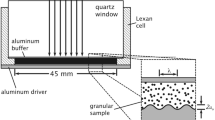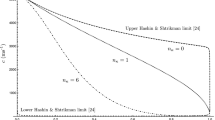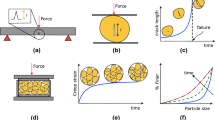Abstract
Continuum equations are numerically integrated using a high-resolution method to characterize the thermomechanical response due to planar impact of initially stress-free granular solid having spatially varying bulk porosity. This response depends on strain history because the crush-up stress necessary for inelastic compaction increases with initial solid volume fraction (ϕ0). Emphasis is placed on characterizing the influence of initial porosity and piston speed on both the grain surface heat flux variation and peak temperature rise within compaction wave profiles for the granular explosive HMX (C4H8N8O8). Heat fluxes near 586 MW/m2, resulting in temperature rises in excess of 400 K, are predicted for weak compaction of granular HMX having an initially dense region adjacent to a highly porous region (ϕ0=0.99, 0.655). Phenomena associated with reflected and transmitted waves from material interfaces are highlighted. Predicted compaction zone end states and heat flux profiles are shown to agree well with those given by a steady-state theory.
Similar content being viewed by others
References
Baer MR (1988) Numerical studies of dynamic compaction of inert and energetic granular materials. J Appl Mech 55:36–43
Baer MR (2002) Modeling heterogeneous energetic materials at the mesoscale. Thermochim Acta 384:351
Baer MR, Nunziato JW (1986) A two-phase mixture theory for the deflagration-to-detonation transition (DDT) in reactive granular materials. Int J Multiphase Flow 12(6):861–889
Bardenhagen SG, Brackbill JU (1998) Dynamic stress bridging in granular material. J Appl Phys 83(11):5732–5739
Benson DJ, Conley P (1999) Eulerian finite-element simulations of experimentally acquired HMX microstructures. Model Simul Mater Sci Eng 7:333
Coyne PJ, Elban WL, Chiarito MA (1985) The strain rate behavior of coarse HMX porous bed compaction. In: Proceedings of the 8th symposium (international) on detonation, pp 645–657
Elban WL, Chiarito MA (1986) Quasi-static compaction study of coarse HMX explosive. Powder Technol 46:181
Gonthier KA (2003) Modeling and analysis of reactive compaction for granular energetic solids. Combust Sci Technol 175:1679–1709
Gonthier KA (2004) Predictions for weak mechanical ignition of strain hardened granular explosive. J Appl Phys 95(7):3482–3494
Gonthier KA (2005) Modeling shear enhanced compaction of granular explosive. Chem Phys J (in press)
Gonthier KA, Jogi V (2005) Multiscale shock heating analysis for a granular explosive. J Appl Mech 72:538–552
Gonthier KA, Powers JM (2000) A high-resolution numerical method for a two-phase model of deflagration-to-detonation transition. J Comp Phys 163:376–433
Issen KA, Rudnicki JW (2001) Theory of compaction bands in porous rock. Phys Chem Earth A 26(1–2):95–100
Mader CL (1998) Explosives and propellants, 2nd edn. CRC Press, Boca Raton NY
McAfee JM, Asay BW, Campbell W, Ramsay JB (1989) Deflagration to detonation transition in granular HMX. In: Proceedings of the 9th symposium (international) on detonation, pp 265–278
Menikoff R, Kober E (1999) Compaction waves in granular HMX. Technical report LA-13546-MS, Los Alamos National Laboratory, Los Alamos, NM
Meyers MA (1994) Dynamic behavior of materials. Wiley, New York
Park SJ, Han HN, Oh KW, Lee DN (1999) Model for compaction of metal powders. Int J Mech Sci 41:121–141
Powers JM, Stewart DS, Krier H (1989) Analysis of steady compaction waves in porous materials. J Appl Mech 56:15–24
Reynolds MS (2000). Numerical simulation of dynamic compaction of granular energetic solids having non-uniform initial porosity. MS Thesis Lamar University, Beaumont, TX
Shu CW, Osher S (1988) Efficient implementation of essentially non-oscillatory shock capturing schemes. J Comp Phys 77:429–471
Shu CW, Osher S (1989) Efficient implementation of essentially non-oscillatory shock capturing schemes II. J Comp Phys 83:32–78
Strang G (1968) On the construction and comparison of difference schemes. SIAM J Numer Anal 5(3):506–517
Swegle JW (1980) Constitutive equation for porous materials with strength. J Appl Phys 51(5):2574–2580
Zauderer E (1989) Partial differential equations of applied mathematics. John Wiley, New York
Author information
Authors and Affiliations
Corresponding author
Additional information
Revised manuscript submitted to Computational Mechanics, November, 2005.
Rights and permissions
About this article
Cite this article
Gonthier, K.A., Cox, C.F. Predictions for the Impact of a Granular Solid Having Spatially Non-uniform Bulk Porosity. Comput Mech 39, 419–437 (2007). https://doi.org/10.1007/s00466-006-0040-2
Received:
Accepted:
Published:
Issue Date:
DOI: https://doi.org/10.1007/s00466-006-0040-2




